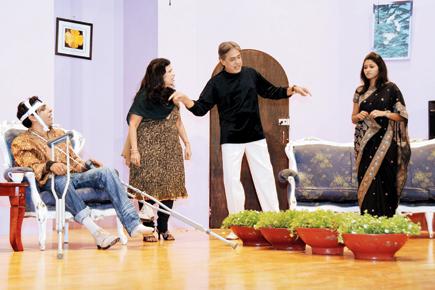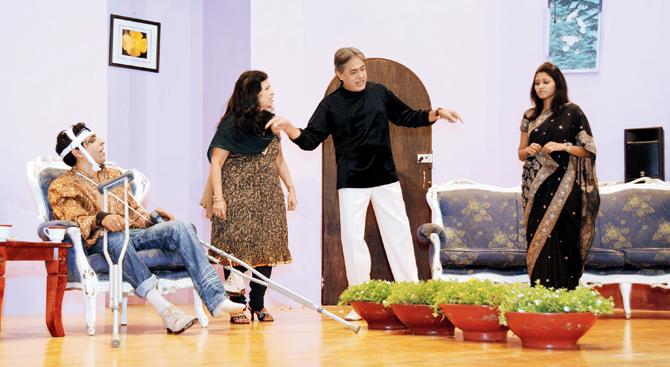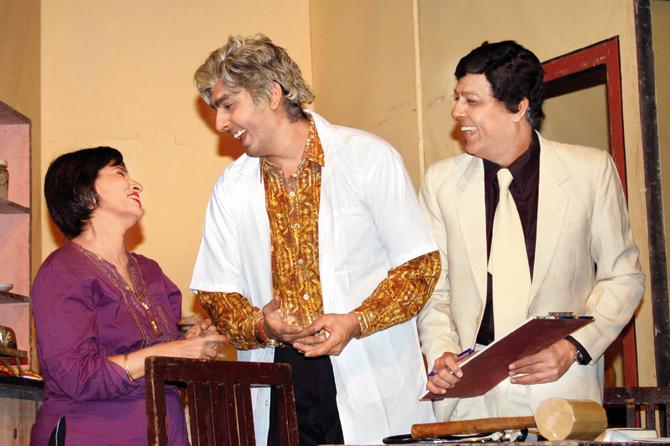Get your entertainment dose from Sindhi theatre as the community hosts the 23rd edition of its drama festival

Niroo Asrani (in black tee) with the cast of Shah ain Maat
![]() Back in 1965, National School of Drama graduate Ramesh Janjani established Sindhu Art Theatre in Mumbai to provide wholesome entertainment to Sindhi community (migrants from Pakistan’s Sind region). “After independence, Sindhis were struggling to make a mark for themselves in free India. In the absence of a designated state, the community was scattered across major trade centres in India. Theatre brought them together,” informs city-based theatre and television actor-director Niranjan Asrani, who re-established the company as Nu Sindhu Art Academy in 2003, post the demise of Janjani. In order to give impetus to Sindhi theatre, Asrani hosts a bi-annual Sindhi Drama Festival in Mumbai and this weekend, marks its 23rd edition.
Back in 1965, National School of Drama graduate Ramesh Janjani established Sindhu Art Theatre in Mumbai to provide wholesome entertainment to Sindhi community (migrants from Pakistan’s Sind region). “After independence, Sindhis were struggling to make a mark for themselves in free India. In the absence of a designated state, the community was scattered across major trade centres in India. Theatre brought them together,” informs city-based theatre and television actor-director Niranjan Asrani, who re-established the company as Nu Sindhu Art Academy in 2003, post the demise of Janjani. In order to give impetus to Sindhi theatre, Asrani hosts a bi-annual Sindhi Drama Festival in Mumbai and this weekend, marks its 23rd edition.

Niroo Asrani (in black tee) with the cast of Shah ain Maat
ADVERTISEMENT
What to expect
Over three days, the festival will re-stage one of the popular Sindhi plays Changu Mangu 420 (an adaptation of the acclaimed English comedy The Sunshine Boys), Shah ain Maat (a family drama), and showcase premieres of Natak Ta Theindo Ei and Toon Sindh Mein Rahi Pau. Asrani has directed all the plays except Toon Sindh Mein Rahi Pau, helmed by Thakur Chawla. The plays feature experienced actors like Jaya Asrani and Lachhman Sachdev, and budding talents like Deepika Hasrajani, Rakhi Gaba and Dipesh Narwani. “All of them are from the community. Their families feel proud to hear them speak the language so well, even after just a few performances with us,” shares Asrani.

A still from Changu Mangu 420
Sindhi theatre: Rise and fall
Like other theatre movements, Sindhi theatre has seen its good and bad days. “Janjani, Gobind Malhi and Ram Panjwani were the pioneers of Sindhi theatre in the early 1960s. They produced plays like Dis Paise Ja Rang and Aayo Nao Zamano which were also staged abroad. Some of the popular plays in 1970s and 80s included Achu Pyar Karyun, Haai Muhinji Dil and Hello Darling,” shares Asrani, adding that over time, it became difficult to hunt for talent who could speak the language fluently. “There is a notion that it's just not cool to speak in Sindhi. We are only committed to changing that,” he says.
For the past seven-eight years, community elders have focused on teaching spoken Sindhi to school-going children. This also helps inculcate interest in watching Sindhi plays. “The crowds who mostly enjoy Sindhi plays are those who love the Sindhi language and understand the culture. Having said that, because we focus heavily on production values and entertainment quotient, youngsters, who prefer a fun night out, are also opting to join their friends for a Sindhi play. We need to sustain Sindhi theatre as we need to continue to build an identity in a new India, especially in absence of a united geographical area or platform,” sums up Asrani.
 Subscribe today by clicking the link and stay updated with the latest news!" Click here!
Subscribe today by clicking the link and stay updated with the latest news!" Click here!







